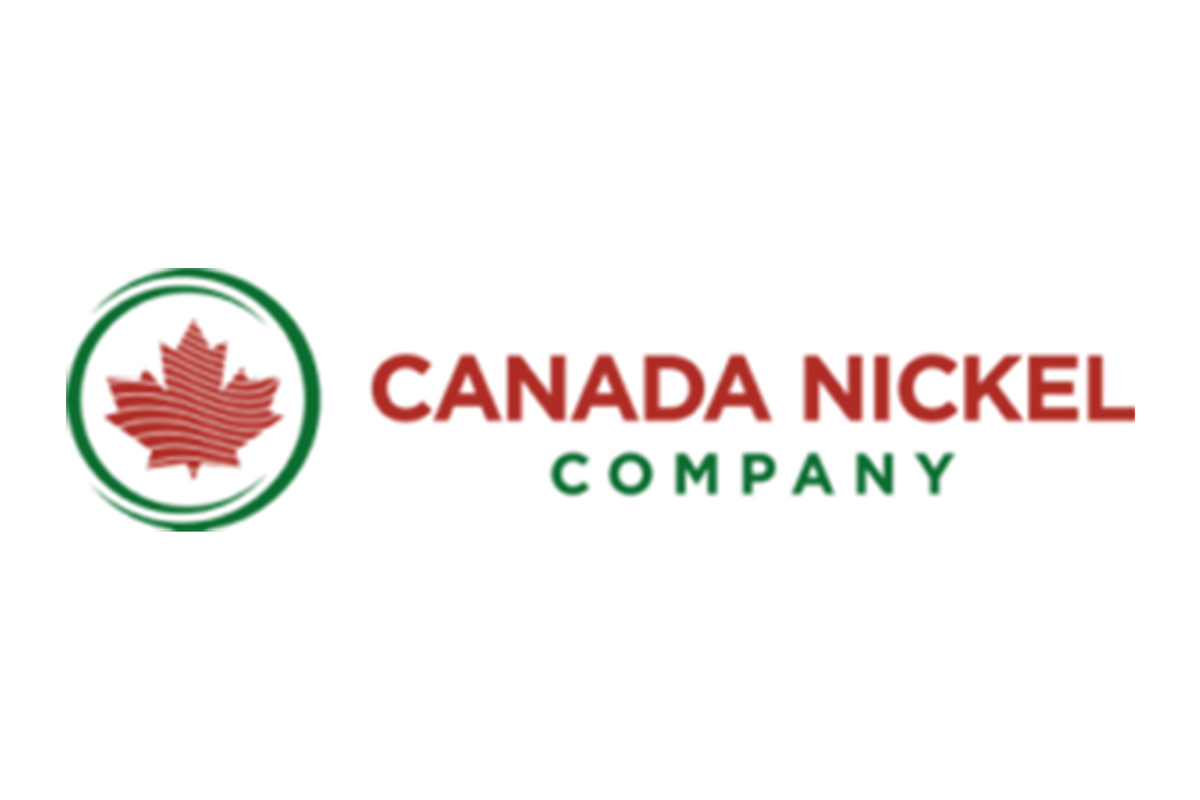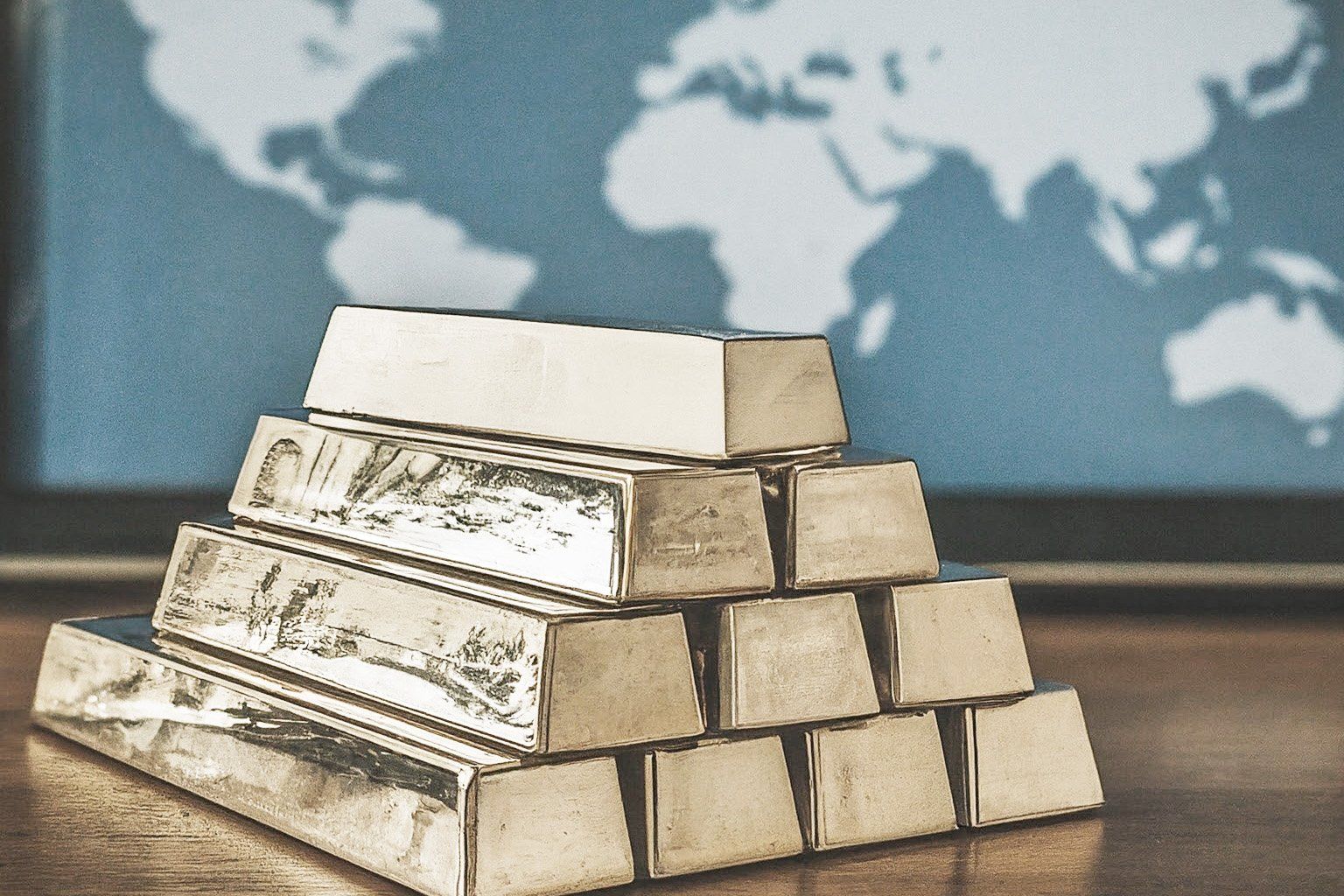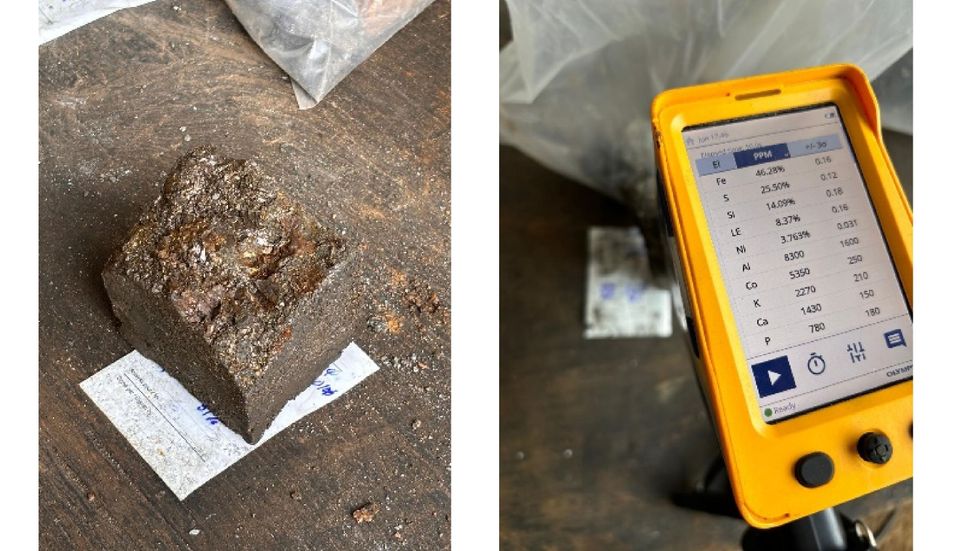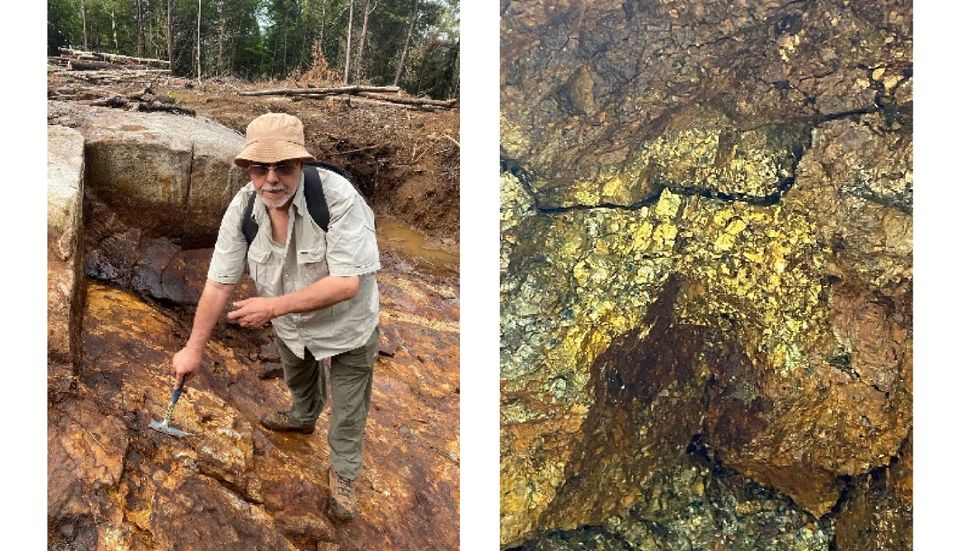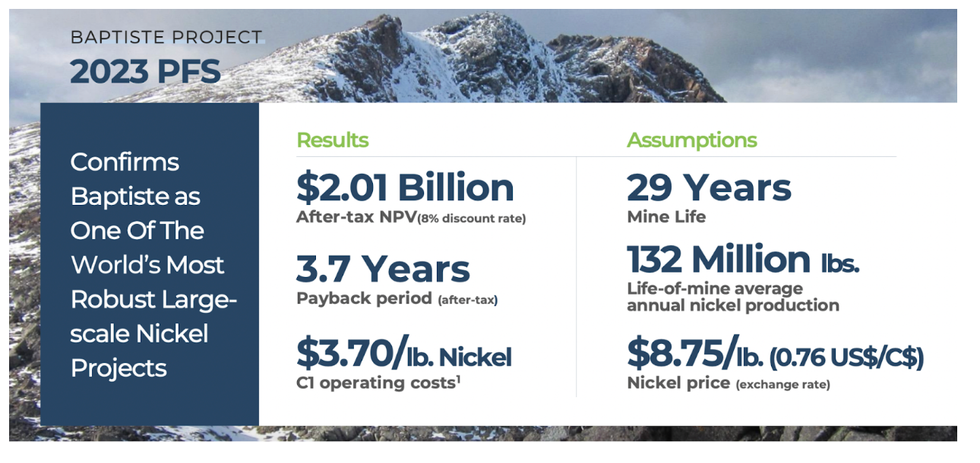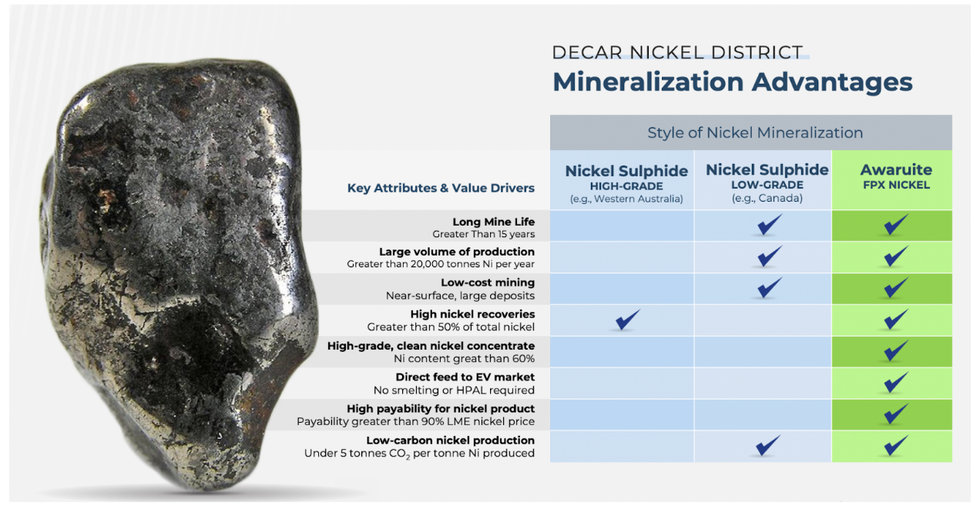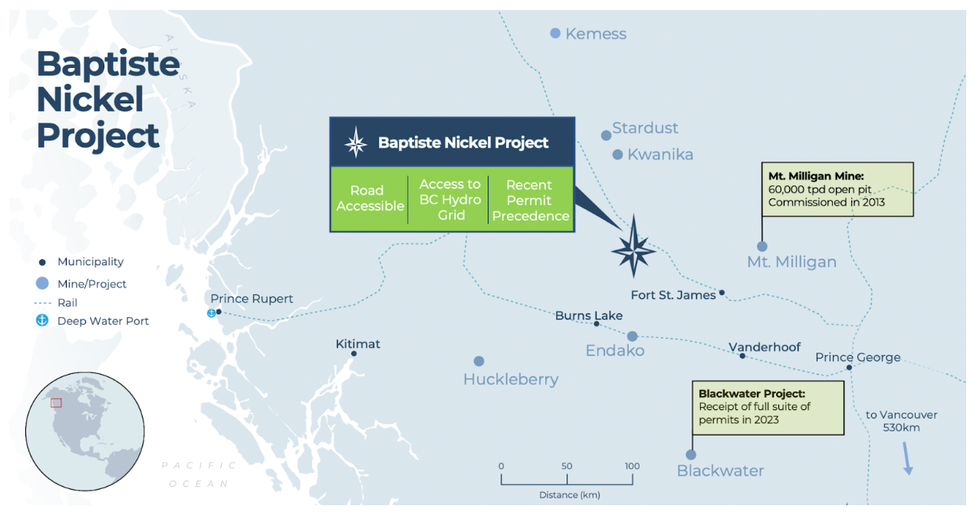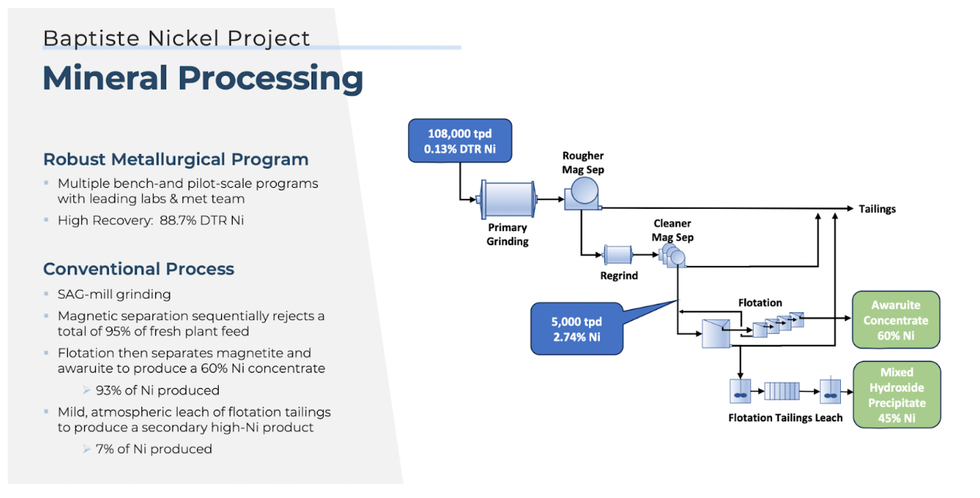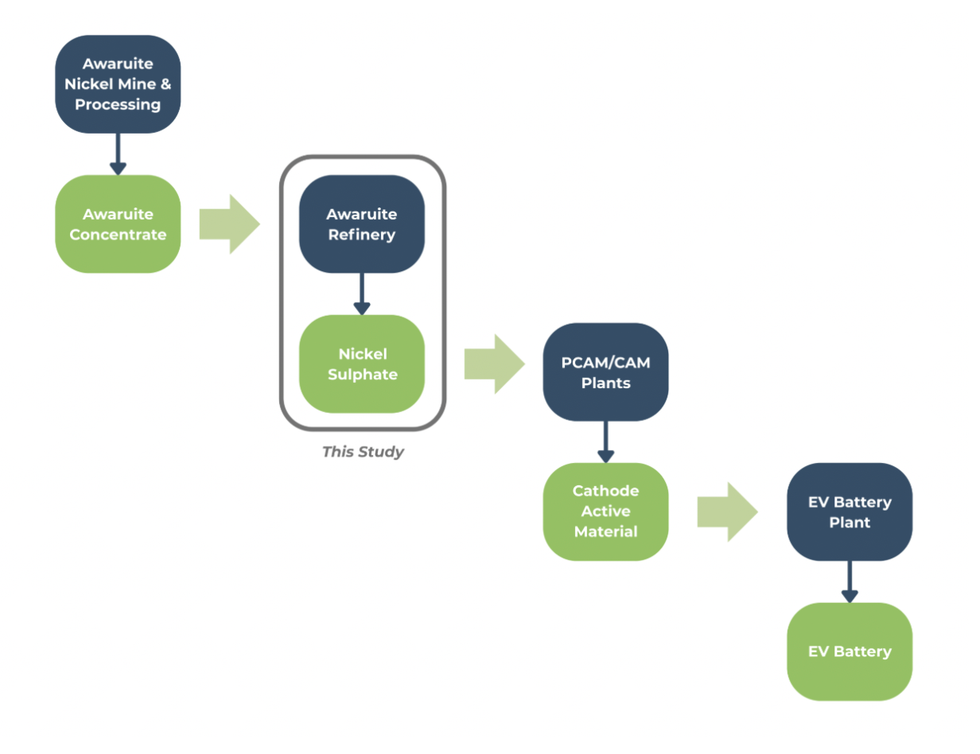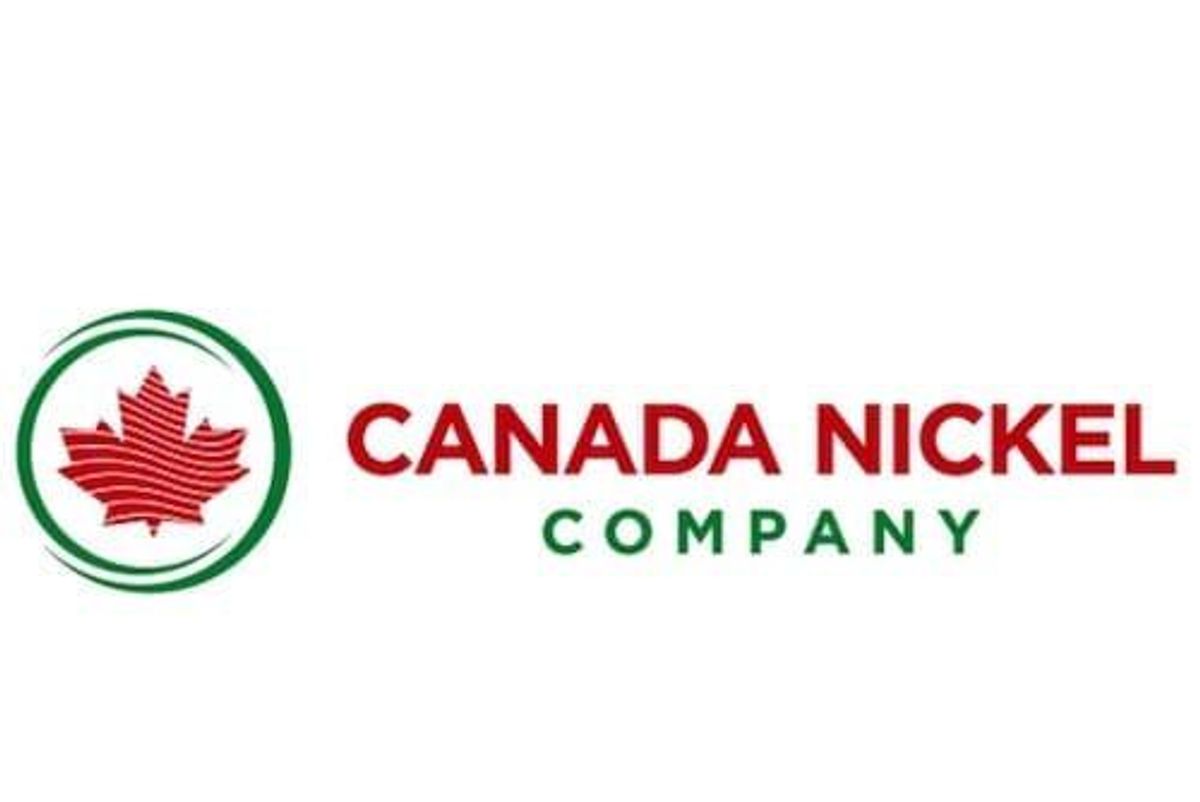
Highlights:
- Flowsheet improvements yield recovery gains and enhanced magnetite concentrate quality (all figures below relative to Preliminary Economic Assessment ("PEA") model)
- Nickel recovery of 62% – 10 percentage points or 19% improvement
- Iron recovery of 45% - 2 percentage points or 5% improvement
- Magnetite concentrate grade of 54% iron – 6.5 percentage points or 14% improvement
- Cobalt recovery of 70% - 30 percentage points or 75% improvement
Canada Nickel Company Inc. ("Canada Nickel" or the "Company") (TSXV: CNC) (OTCQX: CNIKF) is pleased to announce substantial metallurgical improvements that deliver increased recoveries of nickel, iron and cobalt, as well as enhanced iron magnetite concentrate quality, at its 100% owned Crawford Nickel Sulphide Project.
Mark Selby , Chair and CEO said, "I am very pleased with this step change in metallurgical performance that our team has unlocked during this phase of flowsheet optimization. The nickel recovery is substantially higher than the 4-5 percentage point improvement in nickel recovery the Company is targeting for the feasibility study. The improvement in grade and recovery of iron in the magnetite concentrate that has already been unlocked is excellent. I cannot underscore enough the importance of these results, as we believe all of these improvements provide additional value to the project and each percentage point improvement in nickel recovery would yield a US$92 million improvement in the value of the NPV 8% of the project, based on the PEA metrics."
Mr. Selby continued, "Additionally, we continue to aggressively advance on the work programs to complete an updated Crawford resource and feasibility study. We have 5 drill rigs at site – 2 of which recently began geotechnical drilling to support the feasibility study. Our infill drilling at Crawford and exploration drilling programs remain inline with our expectations. Unfortunately, assay results remain very delayed with results from one provider now 16 weeks delayed."
Flowsheet Development program
A key focus of the feasibility study activities is the continued improvement in flowsheet performance given its potential to add significant value to the project, particularly as less than one year of work had been completed on the project before results of the PEA were announced on May 25, 2021 .
The locked cycle test ("LCT") conducted at XPS Expert Process Solutions, a Glencore Company ("XPS"), was the first LCT completed since releasing the PEA. The LCT was completed to measure the impact of flowsheet improvements made over the past four months. The sample selected for testing was a pentlandite dominant sample with a nickel head grade of 0.35%, an iron head grade of 6.0% and a sulphur to nickel ratio of 1.1. This sample was selected because it is a representative sample of what is expected to be processed in Phase 1 of mill operation.
The flowsheet utilized in this test included changes to reagents, grind sizes, and position of magnetic separation in the flowsheet. No further details are being provided at this time as the Company believes these improvements are a proprietary competitive advantage.
Table 1 – Locked Cycle Test - Summary of Results Compared to the PEA Model
LCT Recovery (%) | LCT Concentrate Grades (%) | |||||||||
Nickel Concentrate | Magnetite | |||||||||
Ni | Co | Fe | Cr | Ni | Co | Fe | Fe | Cr | ||
Actual | 62 | 70 | 45 | 21 | 13 | 0.9 | 39 | 54 | 4.5 | |
Modelled | 52 | 40 | 43 | 27 | 12 | - | - | 47.5 | 3.3 | |
Difference | +10% | +30% | +2% | -6% | +1% | - | - | +6.5% | +1.2% | |
As expected, 100% of the nickel recovery in the flotation concentrate reported to the Standard Concentrate product because pentlandite was the primary nickel sulfide mineral in this sample. The nickel concentrate grade of 13% is 1% higher than our target 12% grade for this product and the cobalt grade was 0.9% (no target in PEA). The iron and MgO content of the flotation concentrate was 39% and 7% respectively. PGM assays are pending. The iron content of the flotation concentrate represented 11 percentage points of the 45% overall iron recovery and 1 percentage point of the overall 21% chromium recovery.
Table 2 – Locked Cycle Test – Magnetite Concentrate Quality
LCT Magnetite Concentrate Grades (%) | |||||
Fe | Cr | Ni | MgO | Co | S |
54 | 4.5 | 0.13 | 10 | 0.008 | 0.15 |
The iron grade of 54% is a substantial improvement over the modelled grade of the 47.5% iron utilized in the PEA. The chromium grade of 4.5% is higher than the 3.3% chromium grade that was modelled in the PEA and the chromium recovery of 21% was lower than target recovery in the PEA of 27%. Of the nickel recovery, 1% was reported to the magnetite concentrate. Given the nickel and chromium content of this magnetite concentrate, it is expected to be utilized in the production of stainless steel and other alloys where the nickel and chromium are a valuable feed.
As cobalt was not a payable metal in the PEA, it was not a priority during the PEA flowsheet development and optimization work. As it is expected to be a payable metal in the feasibility study, improvements in cobalt recovery are also a key focus of flowsheet development. Cobalt recovery was materially improved to 70% (versus of an expected target of 40% in the PEA) to the nickel concentrate which graded 0.9% cobalt.
Before completing the LCT, flowsheet improvements were first demonstrated in open circuit tests on a range of samples from across Crawford with head grades between 0.30 – 0.43% Ni and range of mineral compositions. The open circuit tests demonstrated an increase of at least 6 percentage points in nickel recovery and average increases in nickel and cobalt recoveries to the flotation concentrates of 9% and 17% respectively (See Table 3 and Figure 1 below). This result does not include the contribution of nickel from the magnetite concentrate, as this circuit was still under development during some of these tests. For three out of the four samples, modelled nickel recovery was achieved in the flotation circuit alone without any contribution from the magnetite concentrate.
Table 3 – Open Circuit Tests – Comparison of New Flowsheet versus PEA Flowsheet
Summary of Flotation Recovery for Nickel and Cobalt
Ore | Head Grade | Nickel Flotation Recovery | Cobalt Flotation Recovery | |||||||
Ni | S | S/Ni | Before | After | Diff. | Before | After | Diff. | ||
Sample 1 | HGC | 0.30 | 0.11 | 0.37 | 26 | 42 | + 16 | 30 | 60 | + 30 |
LCT Sample | HGC | 0.31 | 0.30 | 0.97 | 53 | 60 | + 7 | 62 | 80 | + 18 |
Sample 3 | HGC | 0.38 | 0.25 | 0.66 | 46 | 52 | + 6 | 51 | 60 | + 9 |
Sample 4 | HGC | 0.43 | 0.26 | 0.60 | 56 | 62 | + 6 | 41 | 53 | + 12 |
Average | + 9 | Average | + 17 | |||||||
For further details, including key assumptions, parameters and methods used to estimate the results of the PEA, and data verification, please refer the "Crawford Nickel-Sulphide Project National Instrument 43-101 Technical Report and Preliminary Economic Assessment", with an Effective Date of May 21, 2021 , as filed July 12, 2021 , and available for viewing on the Company's website www.canadanickel.com .
Next Steps in Flowsheet Development
Metallurgical test work through the remainder of 2021 will focus on finalizing a flowsheet for the Feasibility Study which is expected to be completed in 2022.
The Company will continue the flowsheet development work through the balance of the year and is continuing to target improvements in both recovery and quality of the concentrates.
Nickel recovery from the slimes circuit was not included in the reported results and represents a further opportunity to improve flowsheet performance. The nickel recovery in the slimes concentrate was 3.4% with a corresponding grade of 3.3% Ni. This stream has the potential be in combined into the main flotation circuit and be upgraded to further increase nickel recovery.
Qualified Person and Data Verification
Stephen J. Balch P.Geo . (ON), VP Exploration of Canada Nickel and a "qualified person" as such term is defined by National Instrument 43-101, has verified the data disclosed in this news release, and has otherwise reviewed and approved the technical information in this news release on behalf of Canada Nickel Company Inc.
About Canada Nickel
Canada Nickel Company Inc. is advancing the next generation of nickel-cobalt sulphide projects to deliver nickel and cobalt required to feed the high growth electric vehicle and stainless steel markets. Canada Nickel Company has applied in multiple jurisdictions to trademark the terms NetZero NickelTM, NetZero CobaltTM, NetZero IronTM and is pursuing the development of processes to allow the production of net zero carbon nickel, cobalt, and iron products. Canada Nickel provides investors with leverage to nickel and cobalt in low political risk jurisdictions. Canada Nickel is currently anchored by its 100% owned flagship Crawford Nickel-Cobalt Sulphide Project in the heart of the prolific Timmins - Cochrane mining camp. For more information, please visit www.canadanickel.com .
Cautionary Statement Concerning Forward Looking Statements
This press release contains certain information that may constitute "forward-looking information" under applicable Canadian securities legislation. Forward looking information includes, but is not limited to, the metallurgical results, the timing and results of the feasibility study, the results of Crawford's PEA, including statements relating to net present value, future production, estimates of cash cost, proposed mining plans and methods, mine life estimates, cash flow forecasts, metal recoveries, estimates of capital and operating costs, timing for permitting and environmental assessments, realization of mineral resource estimates, capital and operating cost estimates, project and life of mine estimates, ability to obtain permitting by the time targeted, size and ranking of project upon achieving production, economic return estimates, the timing and amount of estimated future production and capital, operating and exploration expenditures and potential upside and alternatives. Readers should not place undue reliance on forward-looking statements.
Forward-looking statements involve known and unknown risks, uncertainties and other factors which may cause the actual results, performance or achievements of Canada Nickel to be materially different from any future results, performance or achievements expressed or implied by the forward-looking statements. The PEA results are estimates only and are based on a number of assumptions, any of which, if incorrect, could materially change the projected outcome. There are no assurances that Crawford will be placed into production. Factors that could affect the outcome include, among others: the actual results of development activities; project delays; inability to raise the funds necessary to complete development; general business, economic, competitive, political and social uncertainties; future prices of metals or project costs could differ substantially and make any commercialization uneconomic; availability of alternative nickel sources or substitutes; actual nickel recovery; conclusions of economic evaluations; changes in project parameters as plans continue to be refined; accidents, labour disputes, the availability and productivity of skilled labour and other risks of the mining industry; political instability, terrorism, insurrection or war; delays in obtaining governmental approvals, necessary permitting or in the completion of development or construction activities; mineral resource estimates relating to Crawford could prove to be inaccurate for any reason whatsoever; additional but currently unforeseen work may be required to advance to the feasibility stage; and even if Crawford goes into production, there is no assurance that operations will be profitable.
Although Canada Nickel has attempted to identify important factors that could cause actual actions, events or results to differ materially from those described in forward-looking statements, there may be other factors that cause actions, events or results to differ from those anticipated, estimated or intended. Forward-looking statements contained herein are made as of the date of this news release and Canada Nickel disclaims any obligation to update any forward-looking statements, whether as a result of new information, future events or results or otherwise, except as required by applicable securities laws.
![]() View original content to download multimedia: https://www.prnewswire.com/news-releases/canada-nickel-achieves-62-nickel-recovery-and-demonstrates-substantial-improvement-in-metallurgical-performance-at-the-crawford-nickel-sulphide-project-301392560.html
View original content to download multimedia: https://www.prnewswire.com/news-releases/canada-nickel-achieves-62-nickel-recovery-and-demonstrates-substantial-improvement-in-metallurgical-performance-at-the-crawford-nickel-sulphide-project-301392560.html
SOURCE Canada Nickel Company Inc.

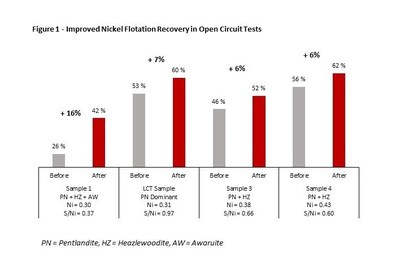


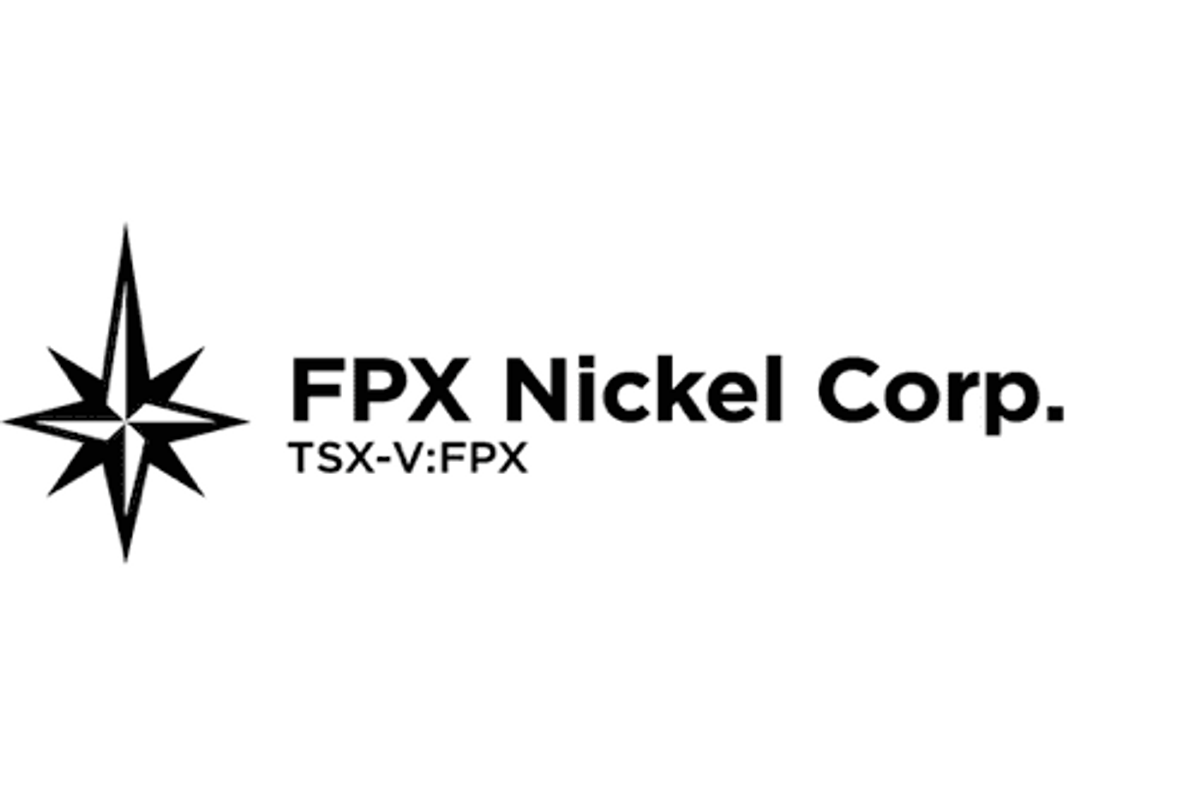
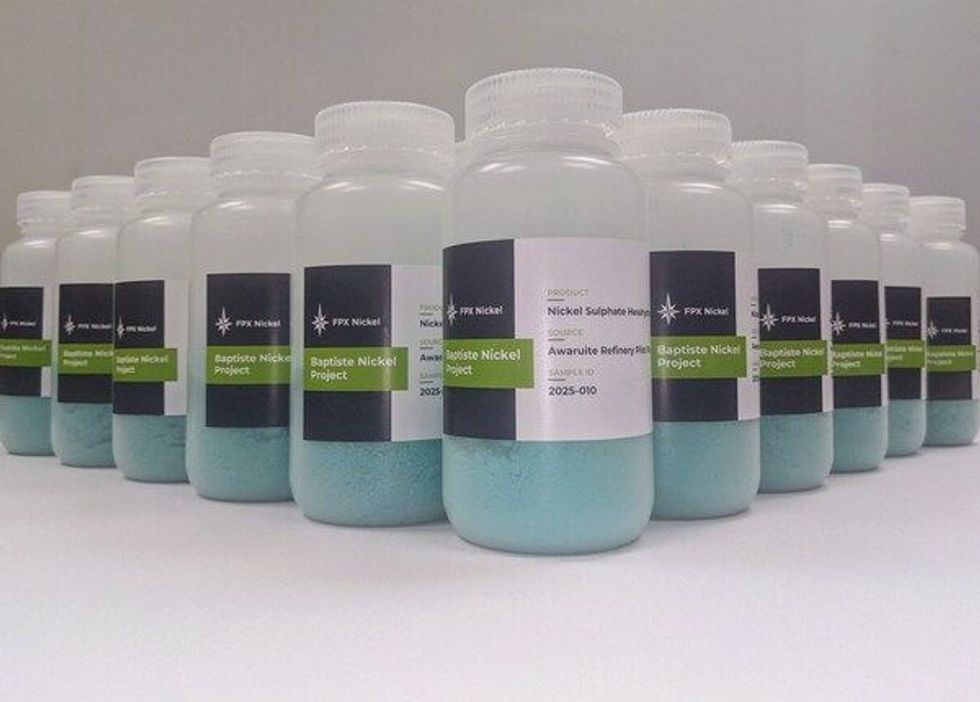
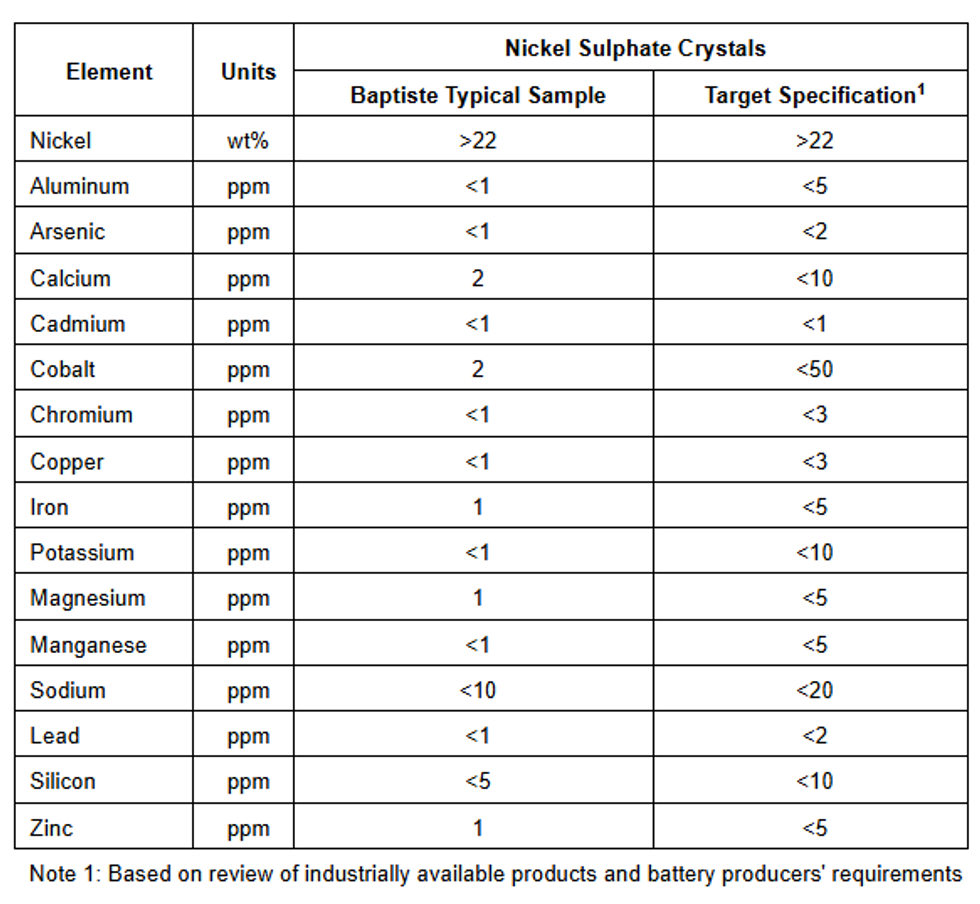 Table 2 – Baptiste Nickel Sulphate Crystal Quality vs. Target Specification
Table 2 – Baptiste Nickel Sulphate Crystal Quality vs. Target Specification